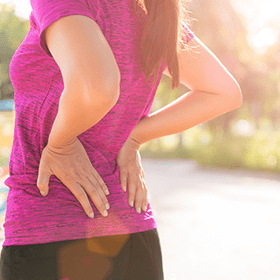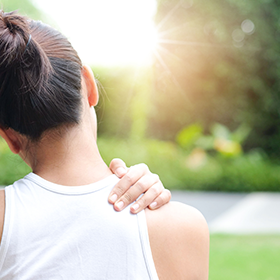By Ben Fletcher
Getting on Top of Achilles Tendon Pain: An Exercise Plan
The Achilles tendon is the biggest and strongest tendon in the body, connecting the calf muscles to the heel bone.
The calf muscles (gastrocnemius and soleus muscles) join into one band of tissue, becoming the Achilles tendon, which is situated on the lower part of the calf. The Achilles tendon then inserts into the heel bone (calcaneus).
As the calf muscles contract, the Achilles pulls on the heel. This happens when you are walking, running and jumping as your heel raises off the floor and you push off with your toes. If you think about some of these actions, particularly during participation in sport or physical activity, you can see that the tendon is placed under a particularly large load.
Although the Achilles tendon is very strong, you can still be at risk of injury. Those of you who have had problems with your Achilles tendon or lower calf have a good idea of how annoying this can be and how limiting it is in your everyday life, in particular, when you want to participate in physical activity.
Common problems you may have experienced in this part of the body could include; Achilles tendinopathy, long-lasting Achilles tightness/stiffness or regular soreness in your lower calf and Achilles tendon.
To reduce pain and discomfort in your Achilles it is important that you improve its overall health and durability, which includes strengthening and loading the tendon. I have outlined below some exercises on how you can load your Achilles tendon. As you can see, there are two phases which progressively increase in intensity.
Phase 1
In phase one, the aim is to start to apply load to the tendon and strengthen the calf muscles (gastrocnemius and soleus).
2 up, 1 down calf raises
This exercise is performed in a bent knee position, and is intended to target the soleus muscle of the calf.
- Raise up on 2 legs and lower down on one.
- Emphasis should be placed upon the lowering or eccentric part of the exercise.
- The key is to lower yourself down slowly with good control.
Seated isometric calf raise
This exercise is performed in a bent knee position, and is intended to target the soleus muscle of the calf.
- You should look to raise your heels slightly and place a dumbbell or something similar on your leg.
- Raise your heel away from the ground and hold this position.
Wall load and drive
This is a great exercise to load the Achilles and strengthen the calf muscles while recruiting other muscles in the lower body as you drive up and extend at the ankle, knee and hip.
- From the loaded position, rapidly drive into the floor to create a straight line from your head to toe.
- As you extend your leg, think about driving the other knee forward so your hip and knee are at a right angle.
- Hold this top position for a second in each rep before loading the leg again.
Phase 2
As you have now developed some strength in the tendon and surrounding muscles, the aim of phase two is to increase the load. You can see that the intensity is increased this time around, as we start to introduce some more explosive training to help increase tendon elasticity. These exercises are looking at the later stages of strengthening which may include returning from Achilles tendinopathy.
Tip toe farmer's walk
This exercise strengthens your calf muscles and Achilles isometrically – meaning the muscle length doesn't change while contracting.
- Raise up on to the balls of your feet while you walk, holding dumbbells in your hands to increase the resistance.
Single leg calf raises
- Stand on the ball of your foot on a raised step or something similar.
- In a controlled movement, lower your heel towards the floor.
- Then in a more explosive but controlled movement, raise onto your tiptoes.
- I'd recommend using the wall or something similar for support as you do this.
Seated single leg calf raises 5-second hold
An exercise to challenge your calf in a bent knee position, and therefore, an exercise that targets the soleus muscle in the calf.
- Place the weight on your thigh and then drive through the ball of your foot to raise onto your tiptoes in a single controlled movement.
- Hold this position for 5-seconds before lowering your heel back towards the floor.
Pogo jumps
As you progress in phase two, you want to increase the load placed on the tendon and the speeds at which the force is produced. A pogo jump is great for this as it starts to prepare the calf and Achilles for activities such as running, jumping and landing exercises.
- The key point in this exercise is stiffness – you want to keep your whole body as stiff as possible with a straight line from your head to toe.
- Try not to bend your knees as you land and focus on attacking the floor with your foot.
Wall drive switches
Progressing on from the wall load and drive, we are now going to rapidly switch our foot position.
- Begin in the extended position with your opposite leg raised – holding your hip and knee at a right angle.
- From here, you are going to rapidly switch your legs over.
- As you do this, think about driving back into the floor with one leg and driving the other knee forward.
- You should maintain the lean position and aim for minimal movement in the trunk.
Important to note
The above information is not intended to be medical advice tailored specifically for you. The first steps towards dealing with your Achilles pain should be to meet with a medical professional and have your injury assessed so you have a proper diagnosis for your pain. The professional in question can then help you with your rehabilitation by creating a personalised programme.

